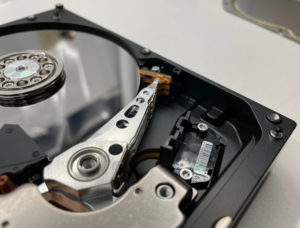 If you’re wondering whether your hard drive can reliably store data, there’s a good chance that it cannot — any hard drive that shows any unusual physical symptoms has a higher-than-average probability of failure.
If you’re wondering whether your hard drive can reliably store data, there’s a good chance that it cannot — any hard drive that shows any unusual physical symptoms has a higher-than-average probability of failure.
In fact, even when a hard drive is perfectly functional, data backup is important: Brand-new hard drives can fail within weeks of purchase without displaying any early warning signs.
With that said, we’ll assume that you have a strong data backup strategy that includes at least one off-site copy of your data. You still need to answer a basic question: Should you keep using your hard drive, or should you replace it?
Start by checking the SMART status of your hard drive.
S.M.A.R.T. (Self-Monitoring, Analysis, and Reporting Technology) is a set of metrics intended to forecast hardware failures. Windows, Mac OS X, and other operating systems monitor S.M.A.R.T. status automatically and will present serious errors to the user.
However, you can manually check S.M.A.R.T. status to determine whether your system detects anything unusual. On Windows:
- Open the Start menu.
- Type cmd in the search box. Right click the Command Prompt and select Run as Administrator.
- Type wmic and press Enter.
- Type diskdrive get status and press Enter.
This will result in a simple output: If the drive is failing, the prompt will display Bad, Caution, or Unknown. If the drive is healthy, the prompt will display OK.
On Mac OS X:
- Click the Apple icon in your menu bar.
- Select About This Mac from the drop-down menu.
- Select System Report.
- Select SATA/SATA Express from the hardware menu on the left side of the screen.
- Look for S.M.A.R.T. Status.
The display will show Verified if the hard drive is working as expected. If the drive is failing, the display will read Failing.
Operating system analysis will only display basic information about S.M.A.R.T. metrics. If you’re interested in more detailed data, read our article: How to Read Hard Drive S.M.A.R.T Data.
Replace your hard drive if you notice any of the following symptoms.
S.M.A.R.T. status should quickly tell you whether your hard drive is still trustworthy. However, we recommend immediately replacing a hard drive if you notice one or more of these symptoms:
- The hard drive makes unusual noises such as clicking, winding, or grinding sounds. Note that all hard drives make some noises during normal operation — but if you feel that your hard drive is getting louder, it’s probably on its way out.
- Files become corrupt or unreadable on a regular basis. Occasional file corruption is normal (more or less), but large numbers of corrupt or unreadable files are a sign of failure.
- The hard drive becomes significantly slower when reading and writing data. Hard drives will become somewhat slower when near full capacity, but massive changes in read/write speed may be a serious symptom.
Remember, every hard drive eventually fails, regardless of its brand, capacity, read/write technology, and other factors. Back up your data regularly.
What should I do if my hard drive is functional, but showing signs of failure?
If your hard drive is showing signs of physical failure and it has the only copy of important files, we strongly recommend seeking help from a professional data recovery provider.
At this point, it may be too late to back up the data — the process of copying the files is intensive and can lead to an HDD failure. If the hard drive is still operational, reputable data recovery providers should be able to safely clone the disk for a minimal fee.
Datarecovery.com provides risk-free evaluations and a no data, no charge guarantee. With full-service laboratories at every location, we provide expert resources for hard drive data recovery, SSD data recovery, RAID recovery, and data sanitization.
Get started by scheduling a risk-free evaluation online or call 1-800-237-4200 to speak with an expert.





